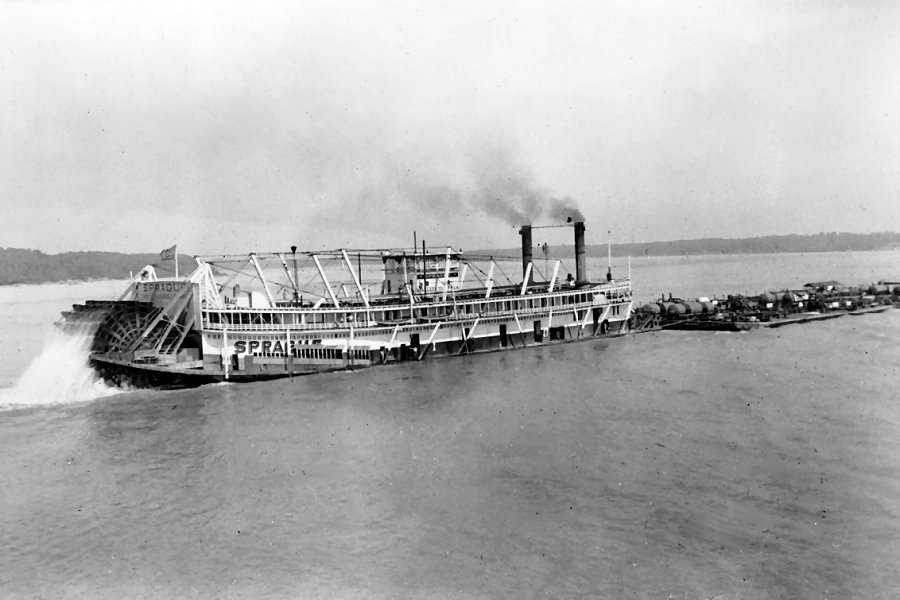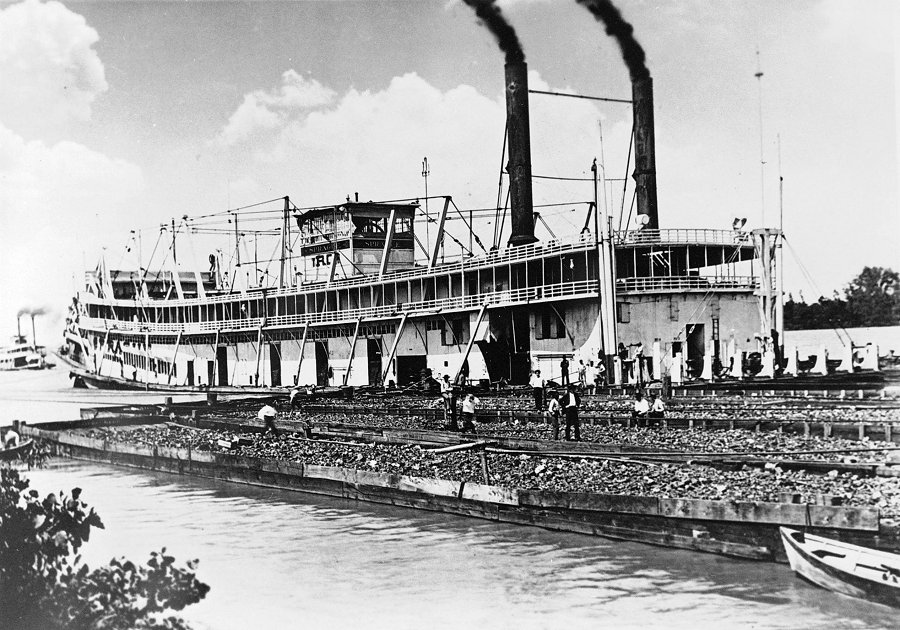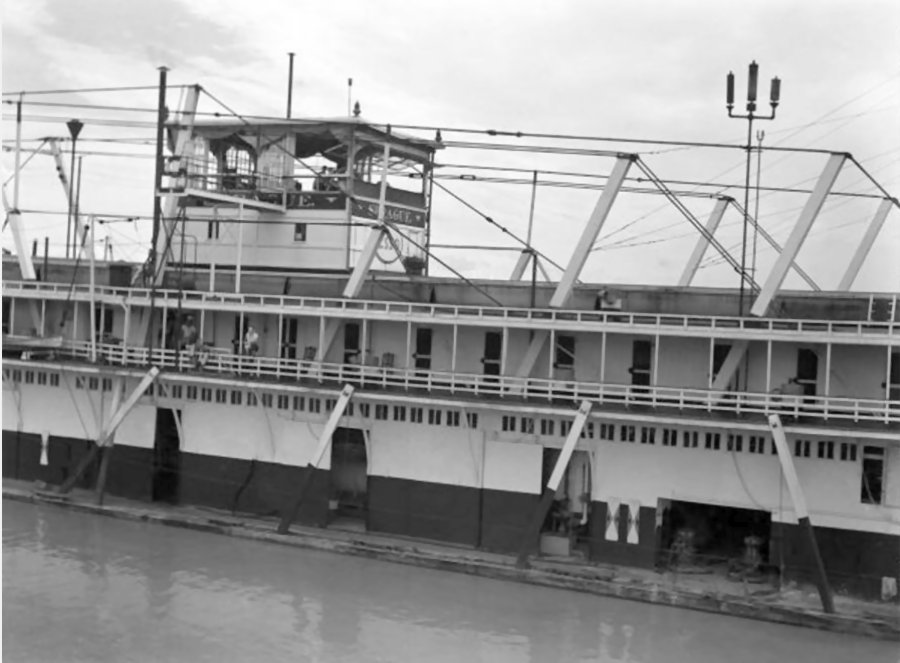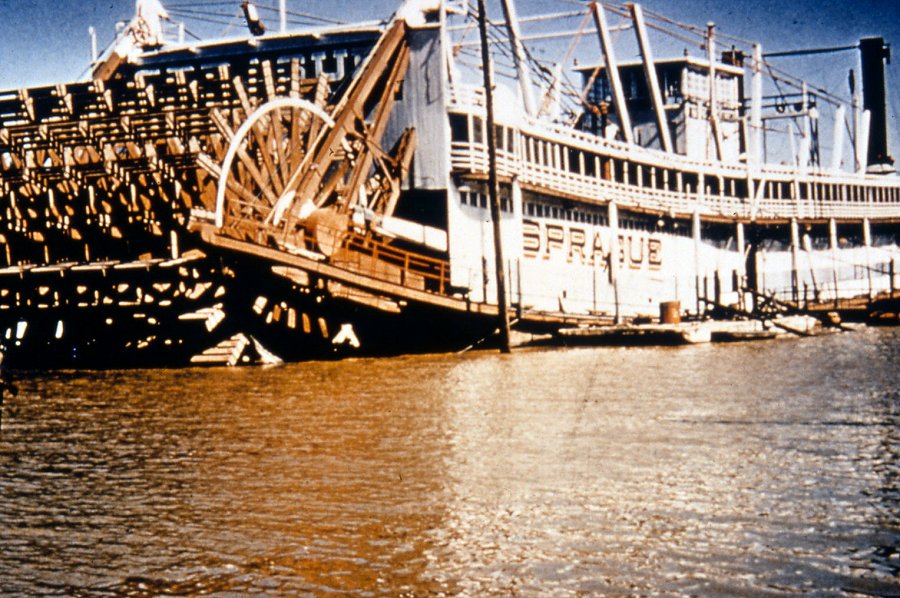Auke Visser's International Esso Tankers site | home
Sprague - (1935-1948 )

The Standard Oil sternwheel towboat "Sprague" built in 1902, for Monongahela River Consolidated Coal and Coke Company (Combine),
sold in 1917 to Aluminum Ore Company and in 1935 to Standard Oil Company.
Decommissioned at Memphis in March 1948. On May 15, 1974 she burned down to the main deck.
Efforts to restore her were not successful and she sank in high water in July 1979 The hull was dynamited in 1981 and that
ended attempts to preserve her.

"Sprague"

The Standard Oil sternwheel towboat "Sprague" in 1946 at Baton Rouge, Louisiana. Detail of the side of the boat.

The once-great steam towboat Sprague, in 1971, which plied the Mississippi and ended up as a theater on the banks
of the river in Vicksburg after WWII.
(Photo courtesy MDAH)
Sprague (Towboat, 1902-1948)
BOAT DESCRIPTION: Sternwheel
BOAT TYPE: Towboat
BUILT: 1902 at Dubuque, Iowa by Iowa Iron Works
FINAL DISPOSITION: Decommissioned at Memphis in March 1948
OWNERS: Monongahela River Consolidated Coal and Coke Company (Combine); Aluminum Ore Company (1917); Standard Oil Company (1935).
RIVERS: Mississippi River; Ohio River
OTHER INFORMATION:
Ways - T2327; Original construction cost: $192,000. The largest steam sternwheel towboat ever built for inland river service. Named for Peter Sprague (and sometimes called that), a Pennsylvania boat builder who superintended the design of the Sprague. She was launched on December 5, 1901. She was too long for the Keokuk Lock and in June 1902 she was towed to St. Louis and her paddlewheel placed on her there. The boiler deck cabin had eight staterooms for officers on each side of the 20-foot-wide cabin. Behind these staterooms were separate sleeping quarters and messrooms for the deckhands and firemen. Open-air bunks were behind the crew's sleeping quarters and were used in warm weather. Cold storage boxes were built to hold 30 to 40 days of supplies. She also had a large kitchen, bakery and laundry. The pilothouse contained the largest pilotwheel ever built: 13 1/2 feet in diameter. On September 2, 1902 the Sprague ran her trial trips in the St. Louis harbor and then made a longer trial trip down the Mississippi. On September 5 she was returning to St. Louis from Cairo when she collided with the showboat Temple of Amusement. The Sprague was attempting to land at Grand Tower, Illinois and cut the showboat in two. Alterations were made to the Sprague in New Orleans later in 1902 and again in February 1903 in Pittsburgh. In March 1903 she left Pittsburgh with 25 loads and added more at Sand Island, Louisville giving her 51 loads. She took them to New Orleans on her maiden voyage and brought back 32 empty coalboats, 12 empy barges and four fuel barges. She blew two cylinder heads on this trip and so in the summer of 1903 her high pressure engines were replaced at Cincinnati. In May 1904 she took a big tow from Louisville to New Orleans consisting of 56 coalboats for a total of 53,200 tons of coal. The 56 coalboats covered an area of 5.9 acres. In February 1907 she towed 56 coalboats plus four barges of coal from Louisville to New Orleans. The entire tow contained 67,307 tons of coal and covered nearly seven acres. A normal tow for the Sprague for southern delivery was 46 coalboats and three fuel barges. On January 22, 1910 while downbound with a tow on the Ohio River near French Island, she was caught in a severe windstorm which sank 14 boats and 3 barges. The damage was estimated at $50,000. In April 1912 the Sprague was upbound at Cairo but the river was too high to allow her to pass under the bridge. Captain Carroll pumped 14 inches of water into the hold thus lowering her and allowing passage. On November 30, 1913 she had her biggest spill while downbound at Plum Point above Oseola, Arkansas. She hit her tow on a stone dike and tore 16 coalboats to splinters while 29 other coalboats and barges were either grounded or sunk. She lost a total of 52,000 tons of coal. She hit the bank near Caruthersville in May 1916 and lost seven coalboats and three barges for a total of 9,000 tons of coal. She was sold to Aluminum Ore in the summer of 1917 and begin towing bauxite ore between Bauxippi, Arkansas and East St. Louis, Illinois. On May 6, 1920 she towed six barges of automobiles from St. Louis to Cincinnati. After unloading, the barges were reloaded with other cars and she left for the lower Ohio and Mississippi on May 9. In 1922 low water between Cairo and Memphis caused towing problems and so she was chartered to Standard Oil of Louisiana . In March 1926 she brought 19 loaded oil barges (containing about 11,000,000 gallons in the tow) down the Mississippi to Baton Rouge. She was downbound in Salem Bend, near Vicksburg, on August 2, 1927 with 10 loads containing 100,000 barrels of crude oil when one of them rubbed a reef. There was an explosion and several crew members were blown overboard. Four barges were burned and lost and four people died. The Sprague was known as "Big Momma" because of her size. Her last day in operation was March 5, 1948 when she was decommissioned at Memphis. She returned to Baton Rouge about a week later and laid up there for awhile, then was towed by Standard Oil to Vicksburg where she was moored in the mouth of the Yazoo River and functioned as a combination museum, boat club and showboat. She continued at Vicksburg (with the exception of being loaned to Pittsburgh for their Bicentennial in 1959) until the early 1970s. On May 15, 1974 she burned down to the main deck. Efforts to restore her were not successful and she sank in high water in July 1979. The hull was dynamited in 1981 and that ended attempts to preserve her.
|